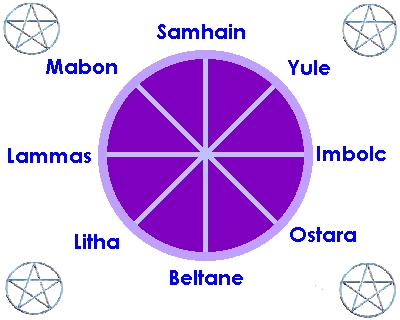| The Sabbats |
 |
| Sabbats are the wiccan religious holidays. A week or two before the sabbats you may notice odd things happening, I call these PEOs (pre equinox occurances) and I find they soon disappear after the sabbat. The wheel of the year continually turns, it is one of the many cycles of life, just as one year ends, another one begins. |
| Samhain (Sow-en) 31st October This is the witches' new year, a time when the veils between the worlds of living and dead are thin. An ideal time to celebrate the dead, some people leave a candle in the window to guide their loved ones to them, or set out a feast to celebrate the new year and leave a place at the table for the dead person/animal. If you have a feast and have leftovers leave them outside for 'wandering spirits' and wild animals. Many people give a small part of their feast to the God and Goddess and leave it on their altar. Samhain is a good time for divination. Yule 21st December This is the winter solstice, the shortest day of the year. Yule is a celebration of rebirth and renewal. The sun is returning so wiccans light fires or candles to guide the sun god back. Traditionally witches would go into the woods and pick a Yule log to tend throughout the night as it burned. Today we place candles in the log and each member of a coven or family will light one candle. You could buy a chocolate one from a shop and bung some candles in the top of that. You can also celebrate with the giving of gifts. Imbolc 1st February At Imbolc (also known as Imbolg, St Bridget's Day, Festival of Bride, Oimelc, or Candlemas) maiden Goddesses are honoured, particularly Bridget. The last reminders of Yule are removed, traditionally with the burning of christmas trees. There are many wells and sites dedicated to Bride or St Bridget, and people leave ribbons and other gifts tied to a tree near the well. You could visit one of these or make an offering on a tree near your home to Bridget, use something natural, like sea salt, a flower or a small crystal. Ostara 21st March This sabbat is also known as Oestara, Eostre and the Spring Equinox. Ostara is a festival of new life and beginnings. Witches decorate eggs to symbolise new life and remember the Goddess Ostara who's festival this is. Her symbols are the egg and the hare, once a rabbit gave her gifts of painted eggs and she was so pleased she asked him to give out decorated eggs to everyone. You could dress you altar with flowers (as it is the beginning of spring) and painted eggs. Think of postive things you could begin on this sabbat, and let negative experiences and thoughts go. Write them down on paper, rip it up and blow it into the wind if you like. Beltane 1st May Just like Samhain this festival is a time when the veils between the worlds are thin. Beltane is the second most important sabbat after Samhain. Beltan means fire of the God Bel, and traditionally people would light beacons and have feasts in Bel's honour. People would dance around the May pole to find a partner, hopeing to be intwined with someone at the end. Single people would go to the Beltane fair wearing green to show that they were looking for love, If they found someone they would spend the night in the woods with them; if they didn't then they would have to spend their night in the woods gathering flowers, this is why it is unlucky to bring flowers into the house at Beltane. Beltane is a common time for Handfastings. |